
ADAS Calibration Service> Vehicle Pre Conditioning - Page 2 of 3
What is Vehicle Pre Conditioning for an ADAS windshield camera calibration?
Vehicle
Pre
Conditioning
for
an
ADAS
calibration
consists
of
critical
steps
that
must
be
done
to
a
vehicle
prior
to
any
ADAS
calibration
to
ensure
that
a
Zero
Point
Camera
Calibration
will
be
as
accurate
as
possible.
These
steps
also
apply
for
sonar,
radar
and
most
LIDAR
sensor
calibrations.
In
order
to
achieve
a
positive
outcome
it’s
also
very
important
these
steps
are
done
in
a
proper
order
and
that
none
of the steps are considered minor or optional and ignored.
•
The dashboard area must be clear of anything that can produce a reflection in the windshield.
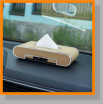
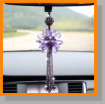
•
The
final
thing
we
ask
of
you
is
that
when
you
arrive
at
our
service
center
to
drop
off
your
vehicle
please
turn
off
all
electronic
accessories
like
the
radio,
GPS,
heat/AC
system, inverters as well as any other extra add on items we may not be aware of.
During
pre
scan
of
the
vehicle
and
again
during
the
ADAS
windshield
camera
calibration
procedure
the
vehicles
ignition
may
be
on
for
over
an
hour
or
more.
It’s
very
important
to
ensure
that
all
unnecessary
power
drains
that
could
affect
the
pre
scan
and
the
windshield camera calibration are turned off.
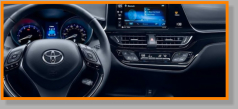
Vehicle pre conditioning consists of the following steps:
•
There can be no suspension modifications beyond the manufacturers allowable specifications
•
The tires and wheels must match placard value
•
The spare tire and jack assembly must be in the vehicle stowed in its proper location
•
No extra weight load can be in vehicle that did not come in it from the factory
•
All fluids to recommended levels such as engine oil and coolant, windshield washer fluid, etc.
•
The dashboard needs to be clear of anything that can produce a reflection in the windshield
•
The fuel tank must be full, to the first click, do not over fill
•
All electronic accessories turned off @ radio, heat/AC, inverters, etc.
•
A battery power supply must be connected to the vehicle to maintain battery voltage above 12 VDC
•
A complete Pre Scan of the vehicles entire electronic system
•
The steering wheel is straight when the steering angle sensor reads 0 degrees
•
The tire pressure must be at the placard value
•
A wheel alignment check is performed (on most vehicles)
•
The windshield must be clean
•
The front wheels steering straight ahead
•
The rear wheels steering straight ahead
•
All exterior lights must be off or covered and all doors closed
•
We need to know if your vehicles wheels and/or tires are not OEM specified sizes.
If
they
have
been
changed
we
need
to
verify
that
they
fall
within
the
manufacturers
allowable
specifications.
If
they
do
not
the
windshield
camera
calibration
cannot
be
performed.
The
reason
why
is
the
cameras
field
of
view
will
change
to
a
new
height
that
will
be
beyond
its
ability
to
be
aimed
to
a
lower or higher position.

Randomly
placed
weight
in
a
vehicle
can
cause
issues
for
a
camera
calibration
in
that
it
can
not
only
affect
the
up
and
down
pitch
of
the
cameras
field
of
view
it
can
also
affect
the
Roll
and
Yaw
which
can
cause
the
camera
to
see
more
left
and
right
then
it
should.
Any
additional
weight
can
and
will
cause
an
inaccurate
camera
calibration.
•
Before
you
leave
home
to
drop
off
your
vehicle
at
our
service
center,
please
remove
all
your
personal
items.
Nothing
should
be
in
the
vehicle
that
didn’t
come
in it when it rolled off the assembly line.
•
Make
sure
your
vehicle
has
its
spare
tire
and
jack
assembly
on
board
stowed
in
its
proper place in the vehicle.
Depending
on
your
vehicle
the
spare
tire
and
jack
assembly
can
weigh
from
anywhere
from
20
to
well
over
50
lbs.
In
the
ADAS
calibration
world
that’s
a
tremendous
amount
of
weight
to
be
missing
from
the
vehicle
during
a
windshield
camera
calibration.







•
We need to know if your vehicles suspension has been modified
Is your suspension standard?
Has it had a lift kit installed?
Has it been lowered?



If
it
has
been
modified
we
need
to
know
exactly
how
much
so
we
can
see
if it falls within the manufacturers allowable specifications.
If
it
does
not
fall
within
the
manufacturers
specifications
we
cannot
perform
a
windshield
camera
calibration
on
your
vehicle.
The
reason
why
is
the
cameras
field
of
view
will
change
to
a
height
that
will
be
beyond
its
capability to be aimed to a lower or higher position.
•
When you bring your vehicle to our service center be sure to check that all fluids are at their recommended levels such as engine oil
and coolant, windshield washer fluid etc. It is difficult for us to add fluids for you because we don’t know what your preferences are.
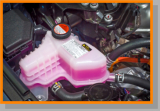
Engine coolant weighs
9.3 to 9.6 lbs per gallon
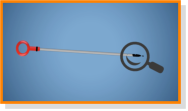
Motor oil weighs
7.7 lbs per gallon
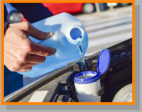
Windshield washer fluid
weighs 7.6 lbs per gallon
The combined weight of all of the fluids in a vehicle can add up to quite a bit and most if not all of them are concentrated in the
forward end of the vehicle so it’s important that every thing is filled to it’s proper level.
Before adding the weight
After adding the weight
An ADAS windshield camera calibration requires the vehicle to be level when it has a full tank of fuel.
If the fuel tank is not full the vehicle will not be level and
The Zero Point Camera Calibration Will Absolutely Not Be Accurate.
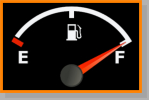
•
When you arrive at our service center for your new windshield and ADAS calibration your vehicle must
have a full fuel tank. Be sure to only fill the tank to the first click as it’s important that is isn’t over filled.
Just
to
show
you
we
didn’t
fake
it,
this
video
shows
what
happens
when
a
125
pound
weight
is
placed
in
the
rear
cargo
area
of
an
SUV
with
a
laser
pointing
at
an
ADAS
Calibration
target.
Many
of
todays
vehicles
have
the
fuel
tank
located
midship
meaning
forward
of
the
rear
wheels.
In
that
case
adding
weight
would
bring
the
front
end
of
the
vehicle
down.
No
matter
where
the
fuel
tank
is
located,
making
sure
it’s
full
makes
a
huge
difference
in
obtaining
an
accurate
ADAS
calibration.
The
average
passenger
car
typically
only
has
a
13
to
16
gallon
fuel
tank
so
what
you
see
in
the
photos
and
video
will
only
be
affected
by
about
half
of
that
movement.
The
average
full
size
vehicle
like
a
Chevy
Suburban
or
a
Ford
Pickup
truck
typically
have
30
gallon
tanks.
We
used
125
pounds
of
weight
in
our
example
so
it
would
be
easier
to
see
the
laser
dot
move
on
the
ADAS
target,
either
way
you
should
be
able
to
get
an
idea
of
how
important
it
is
to
have
a
full
fuel
tank
when your windshield camera is calibrated.
These still photos show what happens when a 125 pound
weight is placed in the rear cargo area of an SUV with a
laser pointing at an ADAS Calibration target.
Something
as
small
as
a
register
receipt
can
cause
a
reflection
in
the
windshield
and
cause
a
camera
calibration
to
fail.
Objects
dangling
from
the
rear
view
mirror
could
also
cause
the
same
issue.
This
should
also
apply
to
every
day
driving
not
just
the
calibration
process
as
it
could
possibly
cause
the
system
to
not
work
properly
at
the
wrong
place
and
moment
when
it’s needed the most to prevent an accident.





If you can have these details accomplished prior to your appointment it will save a great deal of your time and ours in that
all we will have to do is verify that everything is within the perimeters required to perform the windshield camera calibration.


Gasoline weighs in at 6.1 lbs per gallon.
If your vehicle holds 30 gallons of
gasoline that would equal 183 lbs.
Diesel weighs in at 6.9 lbs per gallon.
If your vehicle holds 30 gallons of
diesel fuel that would weigh 207 lbs.

Insurance companies consider the fuel in your vehicle a consumable item and will not pay for it.
If we have to add fuel to your vehicle there will be additional fees that you will have to pay out of pocket.
The fee will be $20.00 plus the price of the fuel.




Below we have listed each one of these steps with an explanation of why they are important.



Insurance companies consider the fluids in your vehicle to be a consumable and will not pay for them.
If we have to add any fluids to your vehicle there will be an additional fee that you will have to pay for out of pocket

The reason the windshield camera calibration will not be accurate is:

Copyright 2013 © Phoenix Glass, Inc. All Rights Reserved
Revised June 2023

Please Like Us
on Facebook














